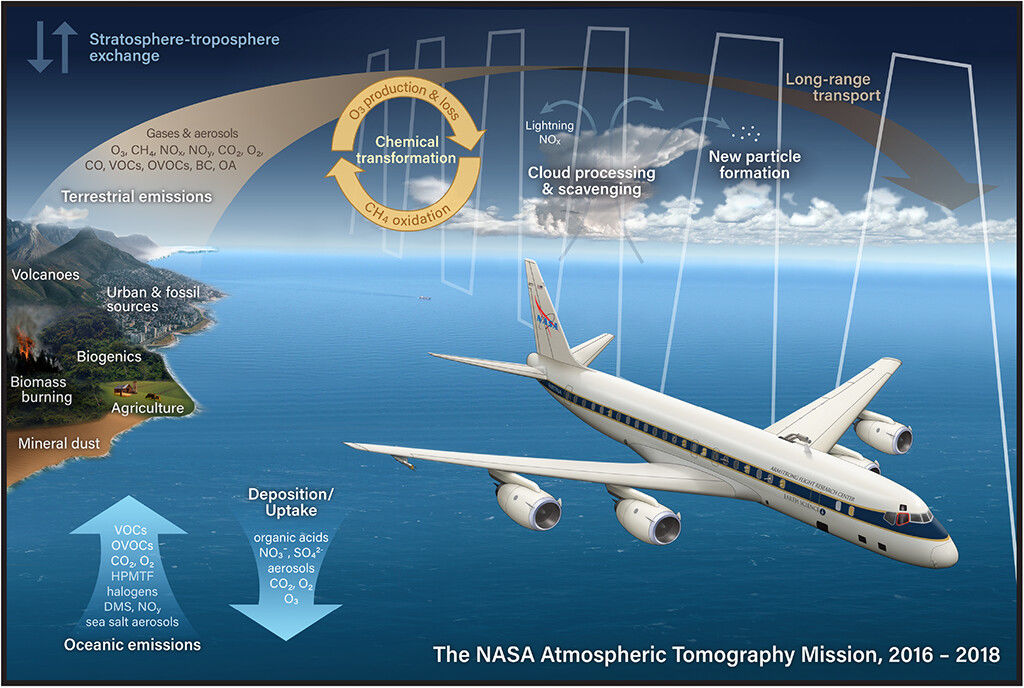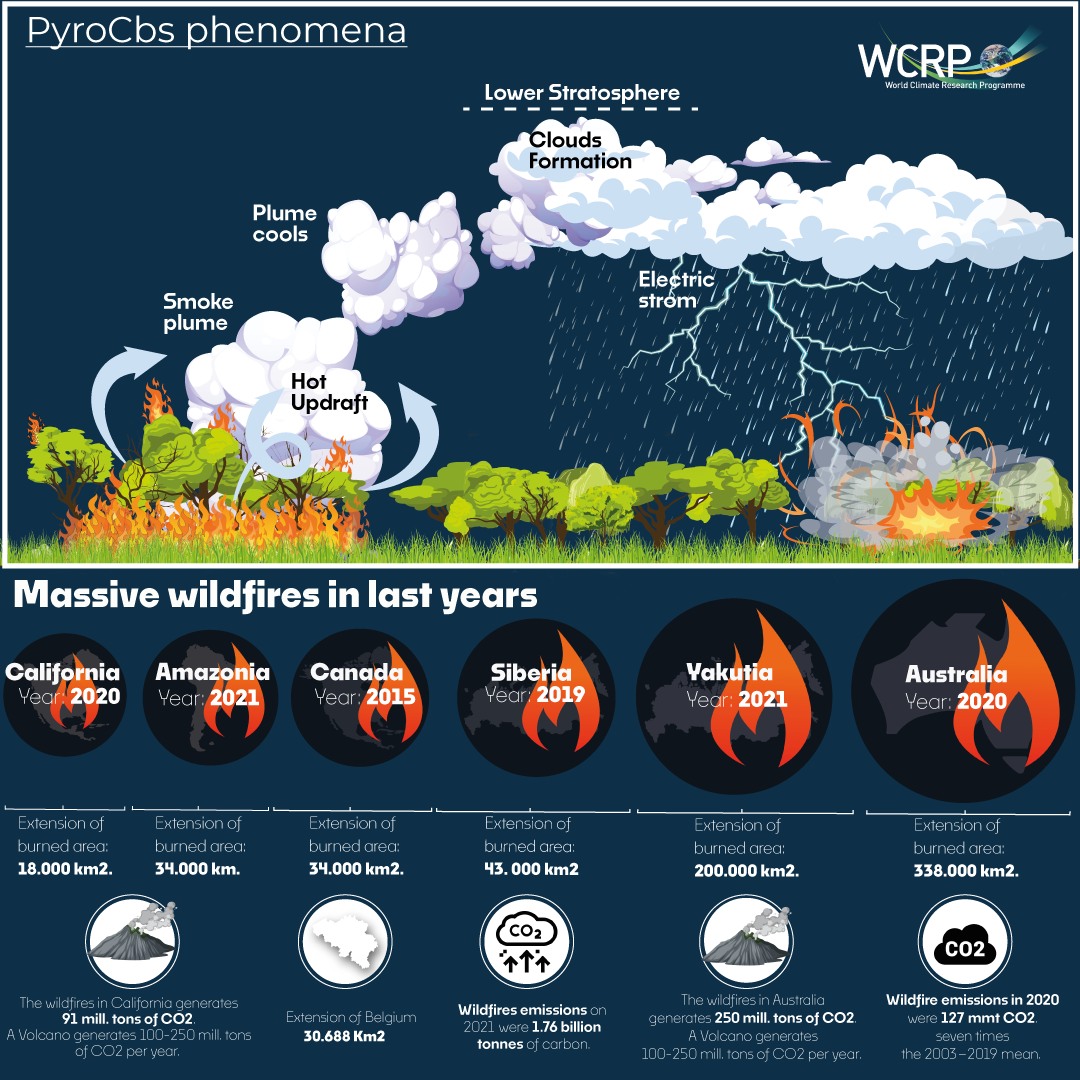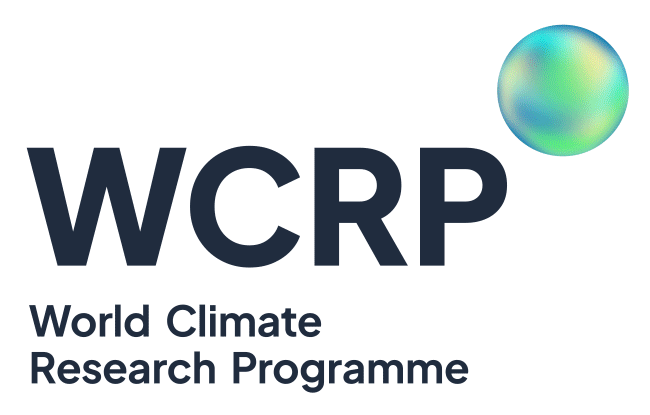Gonzalo Del Arco Ortiz
'Cumulonimbus flammagenitus,' or as they are more commonly known, ''Pyrocumulonimbus' (pyroCb), is the name given to thunderstorms that form in the smoke plumes of fires. These large plumes of smoke are generated during massive fires on the Earth's surface, nuclear bomb blasts, and volcanic eruptions. When they reach a certain magnitude, they can generate large vertical clouds that cause meteorological phenomena such as electrical storms and tornadoes, in some extreme cases. In the case of a forest fire, the intense heat source generates hot air that rises upwards due to convection, and there is a mixing of gases and smoke particles. Energy is released through the condensation of water vapour, leading to the formation of a cumulus cloud from the smoke plume. In some cases, these clouds can develop into a thunderstorm, where ice particles can help to create lightning which in turn increases the risk of generating more and larger fires (Dowdy et al. 2017; Katich et al.2023). These phenomena have a direct impact on the climate system.
Initially, in the 2000s, when the existence of pyroCbs became of interest to researchers, it was considered that only extreme weather phenomena arising from other causes (such as atmospheric storms, volcanic eruptions, or nuclear explosions) could expel particles and material that reach high into the stratosphere. It has now been demonstrated that large wildfires can also produce thunderstorms strong enough to inject layers of black carbon particles into the stratosphere (Fromm et al.2010).
NASA was the first organization to carry out an in-depth study of PyroCbs. The Atmospheric Tomography Mission (ATOM) took place between July 2016 and the end of May 2018. A NASA DC-8 aircraft carried out four scans in remote areas over the Pacific, Atlantic, Antarctic, and Arctic oceans to sample the troposphere and lower stratosphere. The aim was to analyze how tropospheric air is affected by anthropogenic pollution. The largest pyroCb ever monitored at that time was detected, coinciding with a series of massive wildfires in British Columbia, Canada, in the summer of 2017. Measurements of pyroCbs have so far been scarce. Their extent and duration were not known until recently.

'Schematic illustration of the NASA ATom mission. Bulletin of the American Meteorological Society 103, 3, 10.1175/BAMS-D-20-0315.1. © American Meteorological Society. Used with permission.
A second study, known as FIREX-AQ, was conducted jointly by NOAA and NASA in 2019, monitoring pyroCb occurrence during the William Flats fire (Washington State) that year. This second investigation corroborated the hypotheses put forward during ATOM that forest fires may have an increasing impact on regional climate. Aerosols emitted by forest fires affect both air quality and climate. Aerosol particles with an aerodynamic diameter of less than 2.5 microns (PM 2.5) have been associated with increased mortality in human populations and an increase in cases of respiratory diseases as wildfire activity intensifies, thus posing a risk to human health (Wilmot et al. 2022). The 'World Air Quality Report 2019' also showed that Australian cities affected by wildfires exceed the safe limit for PM 2.5 by 78%. In terms of climate, aerosol loading from wildfires has a direct radiative impact due to the black carbon and organic aerosols absorbing and scattering incoming solar radiation, respectively. Additionally, aerosols emitted during wildfires generate indirect radiative effects by altering cloud microphysics, The conditions associated with pyrocumulonimbus cloud formation may continue to become more dangerous due to climate change. (Dowdy et al. 2019; Wilmot et al. 2022).
The massive fires in Australia in the austral summer of 2019/2020, which burned more than 26.4 million hectares of land, offered new insights into the extent and size of these PyroCbs. According to the research by Peterson et al. (2021), the aerosols generated by these fires were comparable to those from the Calbuco volcano eruption in Chile in 2015. Another of the largest Pyrocubs ever recorded occurred on June 30 that year, at the Spark Lake fire in Western Canada. It generated a 160 km2 storm and spewed plumes of smoke at an altitude of 16 km into the lower stratospheric (altitude 10-15 km). Climate change and land-use change are projected to make wildfires more frequent and intense in most regions of the world (Sullivan et al., 2022).

'Representation of the phenomenon known as Cumulonimbus flammagenitus and list of the biggest fires of the last decade. © World Climate Research Programme'.
Restoring ecosystems is an important avenue to mitigate the risk of wildfires before they occur and to build back better in their aftermath. Wetlands restoration and the reintroduction of species (see the example of beavers in Western USA (Fairfax and Wittle 2021)), peatlands restoration and preserving open space buffers are some examples of essential investments into prevention, preparedness, and recovery.

